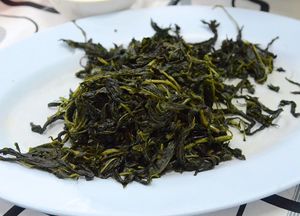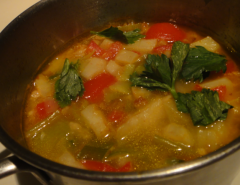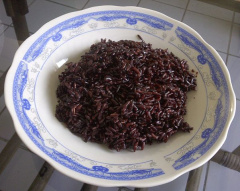Difference between revisions of "Jutean cuisine"
m |
|||
| Line 1: | Line 1: | ||
{{wip}} | |||
The cuisine of [[Jute]] is, owing to the size of the island, its diverse cultures and historical lack of infrastructure, very varied regionally, even locally. | The cuisine of [[Jute]] is, owing to the size of the island, its diverse cultures and historical lack of infrastructure, very varied regionally, even locally. | ||
Revision as of 18:16, 23 March 2024
The cuisine of Jute is, owing to the size of the island, its diverse cultures and historical lack of infrastructure, very varied regionally, even locally.
Traditional Coastal Jutean cuisine
This cuisine is the predominant one in the regions which historically have been populated by the Coastal Juteans (sometimes incorrectly shortened to Juteans), which includes mostly the central and southern coasts, as well as the part of the interior neighboring these coasts, where native Coastal Jutean speakers can be found up onto 30 km inland.
Main dishes
While fish has been a staple for more than two thousand five hundred years now, a large number of dishes remain vegetarian, suiting especially the, compared to other nations, large amount of vegetarians among the population. These meatless dishes often are based on coconuts and various tropical vegetables grown in forest gardens as well as fields or gathered from the forest and the sea. Various fruits often compliment them. Poultry is hardly used, though guineafowl eggs are somewhat popular and can be added to a lot of meals, usually vegetarian ones. However, they are rarely eaten on their own. Other meats or animal products are almost unheard of and are traditionally not used.
A traditional dish is a pudding made of shredded breadfruit, or later plantains, mixed with coconut milk, steamed in a pit dug into the earth, with hot stones above and below. Often fish and/or vegetables are steamed alongside or inside the pudding, or cooked in a pot over a three-stone fire.
Side dishes
Jute leaves
The national food of Jute and Coastal Juteans in particular, the jute leaves aren't just sharing their name with the nation, they are seen as a symbol of it and the Jute plant is the national plant of Jute. Already having been grown on the central and southern coasts for thousands of years, it's now seen all over the island.
Tender and full of taste, which foreigners have compared to spinach, it's also choke full of nutrients, including beta-carotene, iron, calcium and Vitamin C as well as E. It's also rich in antioxidants, all of which has made it earn its place in a healthy diet as well as preventive and curative medicine, where it has been used for example against fever, colds and cystitis. It also can help prevent chronic diseases and cancer, or cure a lack of appetite or fatigue. It's also said to be the secret of the often fair and wrinkle-free skin Juteans are renowned for.
In Jutean cuisine, it can be a simple cooked side dish, sometimes paired with either plantains or sometimes rice, or be made into a simple, thick soup. Other culinary uses include a thickener for all kinds of soups and stews as well as sauces. Sometimes it is also drank as a hot beverage similar to tea. The Saan a havan bar at the beach of Southern Jute City is famous for adding a special secret spice mixture to it. A warm Jute salad is served in Ohajun, located in the northeastern edge of the city.
Plantains
These are nowadays a staple starch of Coastal Juteans after having been introduced in the 12th century by merchants-missionaries from across the ocean. They are harvested early, before becoming fully ripe, and then cut into slices and cooked or fried. Other starchy food, like rice, corn in general isn't as popular, especially not compared to other food groups.
Desserts
Most famous are the pancakes of Jute, and although there are varieties all over the island, the Coastal Jutean ones are the most well known ones. They are made with coconut, green banana or yam flour (later also corn or rice flour), fried banana mash with e.g. chocolate, But cuisine on Jute varies greatly, even more than culture otherwise does on Jute
Pancakes, made with coconut or green banana flour, eggs and coconut milk have become ubiquitous after having been introduced by South Juteans in the 11th century, enough to become associated with the island as a whole and also have varieties in other parts of the island, although the Coastal Jutean ones, often topped with banana slices, hot chocolate or fresh or preserve, are the most famous and popular. Less known abroad, but very popular locally are savory options with fish and vegetables. In more recent times, other flours, such as corn or rice flour have also become used, although they are not as popular as the traditional variations.
Spices
One of the most important spices used in main dishes, side dishes, desserts and beverages is turmeric. Widely added for its bright color and flavor, but also its medical properties. It is used as a remedy against inflammation and oxidation, making it an important part of local medical treatments, and farm therapy, used to treat mental illnesses, often takes places on farms growing turmeric plants.
While not a native plant, turmeric has nonetheless come to be an important part of many Jutean cuisines and cultures. It was introduced in the 12th century alongside the banana and peanut by missionaries from overseas to the outlying small island of Kosomo.
Legend holds that one of them happened across an injured forest walker, a kind of scout scouring the jungle for threats by wild animals or natural forces, but also edible plants and mushrooms as well as anything else that is useful, and nursed them back to health at the temple, where they were feeding them a coconut milk drink with turmeric mixed in. The forest walker was amazed at what they called “liquid sun” and upon hearing the key ingredient is turmeric it soon became the talk of the community.
Due to its costly and difficult import from the other side of the ocean it was highly prized, creating lucrative incomes for overseas traders. This was until the day one of the inhabitants of Kosomo sneaked upon an ocean-faring ship and weeks later on the other side of the world, carrying a tiny bag of the yellow spice, not knowing a single word of the local languages, fought their way through many difficulties to finally find a family growing it.
The family was glad to let someone help them, but watching their crops closely during the day. So the far-flung traveler dug one out at night. They were caught after tripping and falling over a bucket near the parents’ bedroom, but after hearing about how far they had come for the plant the family let them have one, and so they smuggled it and themselves on the next ship back to Jute, where they were celebrated as a hero and turmeric was soon growing on every farm.
Jute City
While cooking in Jute City is still rooted in Coastal Jutean cuisine, due to the centuries of trade and contact with other nations as well as due to the large number of immigrants living in the city it's notably different from the more rural communities, having a lot of international influences and therefore being very "fusional", combining imported ingredients and recipes with traditional ones to experiment with new flavors and thus create new dishes that have proven popular with tourists and domestic visitors to the city alike.
River Jutean
Main dishes
Side dishes
Desserts
Klambari
Main dishes
Historically having been predominantly shepherds and keepers of cattle, a lot of dishes are very meat-heavy, often also featuring rich amounts of hard local cheese. Eggs are rarely used, since keeping poultry is, unlike in the lower regions of the island, uncommon. Aside from beef, lamb and cheese, the dishes always included some fresh or cooked vegetable as a contrast and to liven up the flavor, however they're rarely the center of a meal, with only very few exceptions. Usually, if meat isn't the base ingredient, it's rice or a rice product.
Examples:
- Shepherd red-white soup (pictured), made from vegetables (usually including celery, leek, tomatoes and bell peppers), cubed hard cheese and minced meat.
- Minced meat salad with white Klambari cheese
Side dishes
Black rice
Popular in the more mountainous part of the island in the Southeast, home to the Klambari speaking population. They became the favorite, if expensive, side dish of the region when they were first introduced by Nevira in the 17th century, but recently also have started to gain popularity in other corners of Jute, notably in Helele and Taxonea.
Similar to brown rice, but with an even stronger nutty, almost a bit fruity taste and a soft, but chewy texture, it's a grain to either be adored or despised. Though whoever chooses to stay away from it will also miss out on the high amounts of vitamin B1, B3, B6, E, manganese, phosphorus, iron, zinc, fiber and essential fatty acids. It also includes antioxidants in an amount that might even exceed that of blueberries.
Like other kinds of rice, it's usually cooked or steamed and then served as a simple side dish, however it can also be made into bread, pudding or, as a breakfast or simple evening meal, porridge. Sweets also often contain black rice, which then all have the characteristic deep purple color black rice turns to when cooked. Central Ambato has a lot of small snackbars selling a great variety of dishes, always with black rice on the side or mixed with other fresh, local ingredients.
Desserts
Rice flour, imported from overseas, is used for a lot of desserts, including pancakes, porridges or cookies. These are often topped or filled with local fruits and nuts, apples and walnuts in particular are popular. There are also some flourless fruit-based desserts, which can consist of fried fruits on a stick or in a bowl, mixed with dried fruits or nuts. The sweetener of choice is usually honey.


